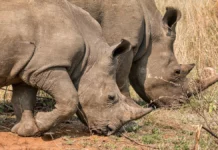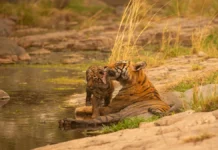Cheetahs, known for their incredible speed and grace, are among the most fascinating and endangered big cats on the planet. RajkotUpdates.news has conducted a comprehensive case study examining the fragile existence of these magnificent animals and the concerns experts have for their survival. In this article, we’ll explore the various factors threatening cheetah populations and discuss potential conservation efforts to protect this iconic species. Know more on rajkotupdates.news:cheetah-magnificent-but-fragile-experts-list-concerns-for-cheetahs.
Background on Cheetahs: Cheetahs (Acinonyx jubatus) are the fastest land animals, capable of reaching speeds up to 70 miles per hour (112 kilometers per hour) in short bursts. Native to Africa and a small population in Iran, cheetahs primarily inhabit savannas and grasslands, where their unmatched speed and agility allow them to hunt various prey, including gazelles and impalas.
Conservation Concerns for Cheetahs: rajkotupdates.news:cheetah-magnificent-but-fragile-experts-list-concerns-for-cheetahs
- Habitat Loss: One of the most significant threats to cheetah populations is habitat loss, primarily due to human encroachment, agriculture, and urbanization. As their natural habitats shrink, cheetahs face increasing difficulty finding suitable territories and prey, leading to a decline in their numbers.
- Human-Wildlife Conflict: As cheetahs’ habitats are encroached upon, they often conflict with humans, especially farmers and livestock owners. In an attempt to protect their livestock, farmers may kill cheetahs, contributing to the species’ decline.
- Poaching and Illegal Wildlife Trade: Cheetahs are targeted by poachers for their skin, which is highly valued in the illegal wildlife trade. Cheetah cubs are sometimes captured and sold as exotic pets, leading to further population decline and animal suffering.
- Genetic Bottleneck: Cheetah populations have experienced a genetic bottleneck, resulting in low genetic diversity among individuals. This lack of genetic variation makes the species more susceptible to disease and other health issues, further threatening their survival.
- Climate Change: As climate change alters ecosystems and weather patterns, cheetahs face new challenges in finding suitable habitats and prey. Changes in temperature, rainfall, and vegetation can negatively impact cheetah populations and their prey species, exacerbating their existing threats.
Conservation Efforts to Protect Cheetahs
- Habitat Preservation and Restoration: One of the most effective ways to protect cheetah populations is by preserving and restoring their natural habitats. This effort can include creating protected areas, implementing sustainable land management practices, and reforesting degraded landscapes to provide cheetahs with suitable territories and prey.
- Community Involvement and Education: Engaging local communities in cheetah conservation efforts is crucial for long-term success. Educating communities about the importance of cheetahs and their role in the ecosystem can foster understanding and cooperation. Additionally, supporting community-based conservation programs can incentivize local people to protect cheetahs and their habitats.
- Anti-Poaching and Wildlife Trade Enforcement: Strengthening anti-poaching efforts and cracking down on the illegal wildlife trade can help protect cheetahs from being targeted for their skin and cubs. This effort requires international cooperation, strong law enforcement, and effective wildlife trafficking monitoring systems.
- Genetic Diversity Monitoring: Conducting research and monitoring the genetic diversity of cheetah populations can help guide conservation efforts and reduce the impact of genetic bottlenecks on the species. Maintaining a diverse gene pool is essential for the long-term survival of cheetahs.
- Climate Change Mitigation: Addressing climate change and its impacts on ecosystems is essential for conserving cheetahs and other wildlife. By promoting the use of clean energy, reducing greenhouse gas emissions, and supporting climate-resilient ecosystems, we can help mitigate the effects of climate change on cheetah habitats and their prey.
- Translocation and Reintroduction Programs: In some cases, translocating cheetahs to new habitats or reintroducing them to areas where they have become locally extinct can help boost their population numbers. These programs must be carefully planned and monitored to ensure the long-term success of the reintroduced cheetah populations.
- International Collaboration: Cheetah conservation efforts require collaboration among governments, non-governmental organizations, researchers, and local communities. By working together, stakeholders can develop and implement effective strategies to protect cheetahs and their habitats, ensuring the long-term survival of this magnificent species.
Cheetahs face numerous threats, including habitat loss, human-wildlife conflict, poaching, genetic bottlenecks, and climate change. However, through concerted conservation efforts such as habitat preservation, community involvement, anti-poaching measures, genetic monitoring, climate change mitigation, translocation programs, and international collaboration, it is possible to safeguard the future of these magnificent but fragile animals. We must act now to protect cheetahs and preserve their unique role in the ecosystem for generations to come.
Conclusion
Cheetahs are magnificent creatures, yet their existence is fragile due to the numerous threats they face, such as habitat loss, human-wildlife conflict, poaching, genetic bottlenecks, and climate change. However, there is hope for their survival through dedicated conservation efforts. By focusing on habitat preservation, community involvement, anti-poaching measures, genetic monitoring, climate change mitigation, translocation programs, and international collaboration, we can work towards ensuring the long-term survival of this iconic species. Know other aspects of rajkotupdates.news:cheetah-magnificent-but-fragile-experts-list-concerns-for-cheetahs.
We must recognize the importance of cheetahs in maintaining balance within ecosystems and act to protect them. As governments, conservation organizations, researchers, and local communities come together to implement effective strategies, we can overcome the challenges threatening cheetah populations and secure a brighter future for these magnificent yet fragile animals.





















